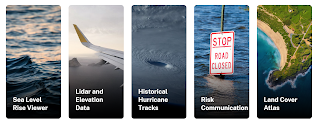Nature-Based Solutions for Mitigating Climate Change
Today Sarah attended a workshop offered by FEMA on Nature-Based Solutions for Mitigation Hazards. Why would an archaeologist be attending this training? We do a lot of education and outreach with the community, including our Heritage Monitoring Scout (HMS Florida) workshops and multiple presentations for public libraries and civic groups. We front end these outreach programs with the science of climate change and identifying the problems climate change brings to heritage sites. What we don't do enough is focus on next steps. We ask participants in our Community Conversations about Heritage at Risk workshops what coastal heritage will be lost, and where roles and responsibilities lie. But our programs are as yet weak in discussing community resilience and what green options there may be in the areas where our program participants live.
Also, I took the workshop to remind emergency management officers, health and safty staff, and planners that heritage is an importance part of all communities and to consider them in their processes and procedures.
The FEMA workshop was held in the St. Johns County Emergency Operations Center. The EOC is ground zero for managing major events such as hurricanes. The facility itself is media for an archaeologist to take in- how it is designed, how it is organized, how to facilitate coordination among government offices. Previously I took FEMA's Incident Command System (see May Day post). In this space you can imagine how ICS is initiated (such as Florida in an advance warning hurricane cone). The big screens harken back to scenes from NORAD featured in movies in the 80s. There are six pods around the room with integrated phone bank and computers accessible to all depatments.
What I found most useful during the Nature-Based Solutions workshop was the case studies and examples of what is possible. I think that is what the public is most often asking us to provide. Not just provide education on the science of climate change and the scale of the threat, but what can be done.
Some of my favorite resources shared today:
1. NOAA's Digital Coast Portal provides data. Click on the link and you can select from five portals: SLR viewer, LiDAR and Elevation Data, Historical Hurricane Data, Risk Communication, and Land Cover Atlas. I have used the SLR viewer on a weekly basis for years, but I've never navigated to the other data reources provided. These are great resources to gain a more holistic view of a community and explore the overlays.
2. Building Community Resilience with Nature-Based Solutions guide. This publication has plenty of buzzwords with the goal of empowering local communities in implementing nature based solutions.
3. The Plan Integration for Resilience Scorecard™ was created by Texas A&M and UNC Chapel Hill. The page provides three pilot communities: Norfolk, Virginia; League City, Texas; and Nashua, New Hampshire. These model cities used a diversity of core team members, planning documents, and the funding they applied for to address their resilienct need.
4. Babcock Ranch is a case study in a community built with sustainability and resilience in its DNA. This article demonstrated how the town built on solar enegcy proved resilient during Hurricane Ian. The model town include residential houses and commercial centers. Babcock Ranch is not a retirement community, residents of all ages live there including families with small children. The natural flow of water guided wetland design and integrates stormwater management. Only native plans are allowed in the town. All the sustainable features combined demonstrate the success of the towns resiliency plan against major storms. They didn't lose electricity or water.
5. Case study of New Orleans and gentrification after Hurricane Katrina. The Community Reinbestment Act (CRA) of 1977 was passed to reinvest in communities where they live and work. Initially it was passed to combat "redlining." The Act was updated in December of 2023 and expands eligible activities for proactive investment in communities. https://ncrc.org/ncrcs-guide-to-the-2023-community-reinvestment-act-final-rule/. Gentrification and cultural displacement are ongoing issues in tandem with climate change and resiliency best practices. The National Community Reinvestment Coalition report on Gentrification and Cultural Discplacement has more case studies and resources included.
BONUS! Writings of Kendra Pierre-Louis were familiar when I looked at individual articles. In addition to writing she also does public speaking and photography. In particular her book Green Washed: why we can't buy our way to a green planet.
In sum, the training met my expectations for broadening my horizons and awareness of nature-based solutions to resileincy that I hope to share with communities in Florida. It's exciting to see that in addition to models and resources, there are so many case studies. I was dismayed to hear little to no reference to cultural resources. In one of our activity break out groups a planner in St. Augustine and I were able to talk about the cultural heritage resiliency study done by the city in 2018. I hope through recommendations made through the evaluation FEMA will consider more focus on cultural heritage and address how heritage assets can bounce back after major weather events.
Text: Sarah Miller, FPAN Staff
Images: credited under the number in which they occur.






